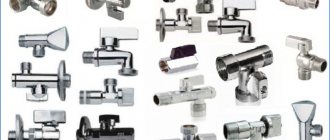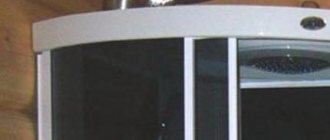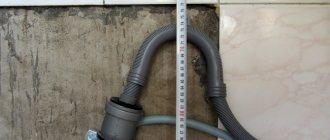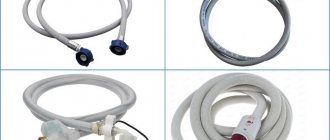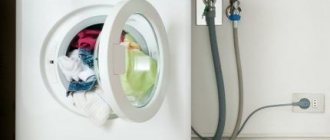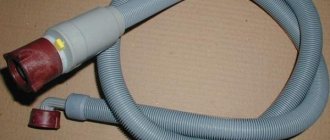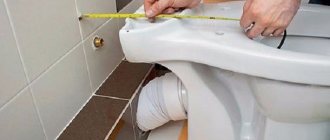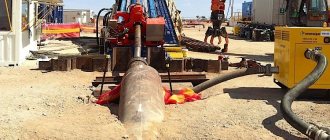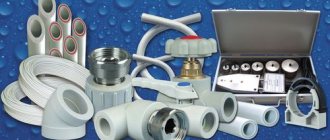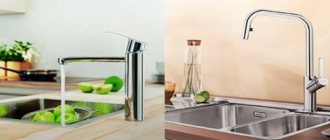31158 0 3
SlavagodM July 14, 2016Specialization: master of interior and exterior finishing (plaster, putty, tiles, drywall, lining, laminate, etc.). In addition, plumbing, heating, electrical, conventional cladding and balcony extensions. That is, the renovation of an apartment or house was done on a turnkey basis with all the necessary types of work.
Connecting a washing machine to the sewer with a pipe with a diameter of 32 mm
If you need to know how to connect a washing machine to the sewer, then you have come to the right place for advice. I want to talk about two main methods that can generally be applied in this case. In addition, I will explain the features of the sidebar, and also invite you to watch the video in this article.
Standard sizes
All drain hoses are divided into 3 main groups:
- ordinary hoses, 1-5 m long;
- telescopic - this is a corrugated hose. When compressed, its length is 60 cm, and when stretched, it is up to 2 meters. The main disadvantage is that this drain is more susceptible to contamination, vibrates strongly when the washing machine is turned on, and breaks when stretched;
- The hose in a coil is sold by the meter. For convenient cutting, it is divided into modular parts. That is, you can cut a piece of the required length from the bay. But for connecting to a washing machine, the length is limited, since a long drain increases the load on the pump.
Drain hoses are made of plastic. There are rubber fittings at the end. If we consider the diameter of the hose, then this is the direct diameter of the installed fitting. The most common diameters are:
- at both ends 2.2 cm;
- on one 1.9 cm, on the second 2.2 cm;
- at both ends 1.9 cm.
Sometimes washing machines have a hose with a fitting for connecting to a pump with a diameter of 2.9 cm, for example, on some LG models.
What else is important to know when choosing a product
The most popular models include flexible, reinforced inlet hoses. The material used to make drain hoses for washing machines is heat-resistant EPDM rubber, placed in a nylon polymer braid. A drain hose of this type, with an operating pressure not exceeding 20 atmospheres, can easily withstand temperatures of 100 degrees Celsius.
Thanks to the use of a small layer of a substance called polyvinyl chloride in the manufacture of the water drain hose, it is very convenient to use and sanitary cleaning. Chrome-plated polyester threads are added to the nylon braid, so units with such drainage devices look great in bathrooms with chrome fittings.
When purchasing an inlet hose, make sure that the reinforced reinforced film is not damaged or breaks. In addition, it must have a well-compressed compression sleeve. Be careful when choosing exactly the product model that will fit your washing machine.
Overview of drain hoses
Today the most popular manufacturers are:
- Helfer is a hose manufactured by a Russian company. Withstands pressure up to 10 bar, maximum temperature up to 60 C. The fittings are standard in diameter - 1.9 cm. The cost for a 3 m hose is about 300 rubles.
- Tubo Flex - hoses from a domestic manufacturer. Withstand pressure up to 2 bar. They are made of plastic of various lengths - 1-5 m. It is recommended to install for siralok: Beko, Samsung, Atlant, Indesit. The approximate cost of a 3 m long hose is 150 rubles.
- TSG - hoses from an Italian company. Maximum pressure – 5 bar. They can have different lengths, which affects the cost. All hoses are equipped with fittings with a diameter of 1.9x2.2 cm. Products are recommended for Electrolux, Whirlpool, Zanussi, Ariston, Bosch models.
How to choose?
When purchasing hoses for washing machines, you need to pay attention to a number of important technical parameters, such as length, maximum permissible pressure and heat resistance.
- The length of the sleeve is selected individually and depends on the layout of the bathroom and the intended installation location of the washing machine. Therefore, before deciding on the size of the model, it is necessary to measure the distance from the taps of the water supply and sewer networks to the household appliance. When determining the length of the hose, it should be taken into account that the hose should not sag too much, bend sharply or stretch. The most common models are from 3 to 5 meters long. It is also necessary to pay attention to the size of the sections of the connecting fittings: they must clearly correspond to the size of both pipes of the machine and the branches of the communication networks.
This will eliminate the need to use various adapters, which increase the number of connections in the system, and therefore increase the likelihood of leaks
- Another important selection criterion is the maximum permitted operating pressure that the hose can withstand. For apartment buildings with a common water supply system, an indicator of 20 Bar will be sufficient, while for private houses with an individual water supply system, it is better to choose more powerful samples, for example, models with the Aquastop system.
Such hoses can withstand up to 70 bar and can withstand both minor pressure surges and medium-force water hammer.
- The next operating parameter that you should pay attention to is the heat resistance of the sleeve. The best option would be to choose models designed for temperatures up to 90 degrees, especially since many manufacturers supply the market with reinforced models that can function normally even at one hundred degrees.
In addition to technical parameters, it is necessary to pay attention to the completeness of the models. This includes the presence of seals, union nuts and other related accessories. In addition, you should carefully inspect the hoses for external damage, and if you find defects in the threaded connections or obvious creases in the hose itself, it is better to refuse to purchase them.
Drain hose extension
Manufacturers of washing machines usually do not recommend lengthening the drain. But what can be done if the sewage system is far from the car or it is located separately, and the standard length for drainage is not enough. In this case, either completely replace the hose or add the required length.
The first method is much preferable, since additional connections increase possible leaks. When purchasing a product, you need to take into account that the hose cannot be stretched too much, that is, you need to take it with a reserve.
The permissible length is no more than 3.5 m. If the drain is longer, this will significantly increase the load on the pumping equipment, which will lead to its premature wear.
An adapter is required to connect two hoses. This is a plastic tube that is inserted into the ends of the drain and secured with clamps.
Recommendations for use
Theoretically, the service life of hoses ranges from 2 to 10 years and depends on many factors, such as the intensity of use of the machine, the quality of tap water and the nature of contamination of things. Therefore, during the operation of the hoses, it is advisable to personally monitor their condition and take timely measures to clean or replace them. This especially applies to drain hoses, which pass through streams of contaminated liquid, are exposed to sudden temperature changes and are exposed to chemical detergents containing surfactants.
At the first signs of blockage, such as disobedience to commands, a drop in the water drainage speed and chaotic blinking of indicators on the touch panel, it is necessary to urgently clean the drain hose. To do this, pour 200 g of soda into the drum, set the temperature to 90 degrees and turn on the wash without placing laundry in the machine. The resulting alkaline solution should quickly dissolve contaminants and clean the hose. If the problem cannot be solved and the water still does not drain, then most likely a button or other hard object is stuck in the hose.
In this case, to clean the sleeve, you will have to unscrew the connections and remove debris manually.
Methods for draining water
The drainage is carried out either into the bathtub or into the sink. In this case, connecting is not difficult. You need to pass the hose through the fixing hook, which must be included in the package, and install it on the edge of the bathtub or sink above the washing machine.
As a rule, this connection option is used by people who do not have the opportunity to connect to the sewer system or this is a temporary method of operation.
The main disadvantages of this drain:
- The sink or bathtub will begin to become dirty all the time due to the supply of waste water.
- You will not be able to take a bath or use the sink while the washing machine is running.
- Dirty water is visible when draining; not all housewives like this.
If the sewerage system is working properly and the washing machine is used on an ongoing basis, it is better to connect it to the sewerage system. This can be done in different ways:
- This method is suitable for people who are ready to specifically organize a drain in the place where the machine is located. Most often, this is done when renovating an apartment, since the standard layout does not provide space for washing machines when building a house. This drain can be done using a separate siphon, which is connected to the sewer.
- Installation of the drain into the sewer itself using a sealing collar. In this case, you need to ensure that the drain is securely in the cuff and has sufficient length. The hose must not be too tight or easily removed from the cuff.
- Drain through siphon outlet. Most often, this siphon is installed under the sink. This requires reliable fixation of the hose fittings so that there are no leaks at the connection point. For this purpose clamps are used.
Design features
The inlet hose is needed to connect the washing machine (they are also suitable for dishwashers) to the pipe through which the water supply is carried out. A high-quality tube is a guarantee of the absence of any leaks. Therefore, after the next wash, you will not find puddles in the bathroom all over the floor and will not have to pay for repairs to the neighbors’ apartment below.
A device for connecting a washing machine to a water supply pipe is made from polyvinyl chloride. For additional strength, manufacturers add nylon braid or reinforced threads to the design.
At both ends of the hose there are fittings and nuts made of plastic. Also, for a more stable connection of the device, pressed metal sleeves must be present near the nuts.
When choosing an inlet hose, consider the distance from the washing machine to the water supply pipe
The manufacturer applies a marking on each hose indicating the maximum permissible water pressure - most often this figure is 20 Bar.
Attention! It is best to tighten the plastic nuts on both ends of the hose by hand. If you use metal tools, they may crack.
Replacing the hose
Each washing machine model is individual, that is, the drain is attached in different ways. But there are basic rules, regardless of the brand of washing machine:
- First you need to turn off the power. The cord must be secured to the back of the washing machine so that it does not get in the way during work.
- Next, the water supply is turned off. When disconnecting the hose, the main thing is not to lose the gasket that is located in this tube. In the place where the drain was attached, you need to install a plug, and attach the hose directly to the back of the washing machine with the pipe facing the top.
- To replace the hose, access to the internal elements of the machine is required. As a rule, the hose is attached near the pump. For ease of work, you need to unscrew the top roof of the housing. The hose most often protrudes from the top or bottom of the back of the washer. To replace it, you need to unscrew it from the pump and housing.
- The hose is then disconnected from the sewer system. Now we begin to install the new product. All washing machine models do this in different ways, so it is recommended to study the instructions.
The maximum hose length is most often standard, especially when it comes to diameter. If any of the fittings of the washing machine are non-standard, then you need to specially order a hose or increase the length. Something you can easily handle with your own hands.
Peculiarities
Hoses for washing machines are flexible pipes used to supply clean water and drain contaminated water during washing. For their manufacture, rubber and polyvinyl chloride are used, and to give the products additional rigidity, nylon braid or reinforced threads are added to the structure. The ends of the hoses are equipped with plastic fittings that serve to connect the machine to sewerage and water supply systems. Each plastic nut is additionally reinforced with a pressed metal sleeve, giving the connection special strength and rigidity.
Almost all hoses are designed for the standard internal diameter of the inlet and outlet pipes of washing machines, which is 3/4". This makes the hoses compatible with most washing machines, and makes it much easier to select the right model if replacement is necessary.
There is a marking on the surface of the hoses indicating the maximum permissible fluid pressure, which, depending on the model, varies from 20 to 70 Bar.
Tools and consumables
The choice of tools is influenced by the material from which the sewer pipes are made. But in most cases the following set will do:
- adjustable wrench and wrench;
- drill;
- screwdriver;
- pipe cutter if necessary to work with a metal-plastic pipe.
Also, the set of materials can be supplemented with other equipment, taking into account the chosen drainage method:
- hose, the length of which depends on the connection distance;
- seals;
- ball valve;
- self-tapping screws when connecting through the edge of the bathtub;
- tee when organizing drainage with standard equipment;
- siphon with pipe;
- silicone sealant or liquid rubber.

